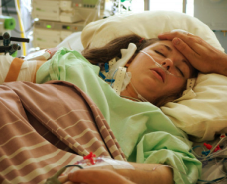Risk Watch (July '18)
Selected research, publications, and resources to promote evidence-informed risk management in Canadian healthcare organizations. Prepared by HIROC. Some titles are open access while others may require a subscription or library access; the librarian at your organization may be able to assist you. Please contact riskmanagement@hiroc.com for assistance if required.
Patient Transitions / ICU

de Grood C, Parsons Leigh J, Bagshaw S, et.al. CMAJ. 2018 (June);190(22):E669-E676.
Cohort study across eight Canadian hospital settings to explore how transfers of care from ICU to hospital wards can be improved. Perspectives through interviews by 35 participants of which 51% were patients and family members and 49% were hospital physicians and nurses. Results showed three overarching themes that described perceived barriers and facilitators to high-quality transfers of patients: resource availability (physical and human); communication; and institutional culture. The most common recommendations to improve transfer of care from ICU to hospital ward were: implement standardized ICU discharge communication tools between both hospital providers and patients/family for communication continuity, use multimodal (written and verbal) communication to facilitate timely, accurate and mutually reinforcing information transfer, and develop procedures to manage delays in transfer to ensure continuity of care.
Health System Improvements
Changing how we think about healthcare improvement

Braithwaite J. BMJ. 2018 (online May):1-5.
Article describing how the rate of adverse events has remained about 1 in 10 patients for the past 25 years and “complexity science offers ways to change our collective mindset about healthcare systems, enabling us to improve performance that is otherwise stagnant” (p.1). Author noted six principles for a change approach: 1) pay more attention to how care is delivered at the frontline, 2) all meaningful improvement is local, 3) acknowledge clinicians doing complex work every day and get things right far more than wrong, 4) four common factors for achievement: begin with small scale initiatives; convert data to intelligence; collaboration underpins all productive change; always start with the patient at the centre of the measure, 5) be more humble in aspirations, 6) adopt a new mental model that appreciates complexity of care systems. A listing of 20 complexity oriented enablers and insights is included.
Mortality Alerting System / Hospital

Cecil E, Bottle A, Esmail A, et al. BMJ Qual Saf. 2018 (online first, May):1-9.
Study to investigate the association between mortality alerts and subsequent trends in relative risk of mortality in UK National Health Services hospital trusts. Authors noted the mortality alerting system was critical in triggering the initial investigation into Stafford Hospital and highlighting severe failings that led to a public inquiry. In the study, 203 alerts were sent to hospital trusts. The total number of deaths in the alerting hospitals was 14,452 over the study period with 11,083 expected deaths in a total of 266,468 admissions. Results showed on average a 5% monthly increase relative risk of mortality 12 months prior to an alert. Mortality risk fell on average by 61% during the nine month period immediately following an alert. Authors outlined possible reasons for the mortality rates falling such as hospital monitoring.
Patient Safety / Paediatrics

Phipps A, Paradis M, Peterson K, et al. Jt Comm J Qual Saf. 2018 (June);44(6):334-340.
Article describing the implementation of a multifaceted patient safety program in a large children’s hospital in the US and its impact on serious safety events (SSEs) and hospital acquired conditions (HACs). The program included: safety moments, leadership rounding, cause analysis structure revisions, safety event reporting enhancements, error prevention training, leadership training, identifying priority HACs, and Eye on Safety Campaign. Results showed SSEs decreased from 0.19 per 10,000 patient days (prior to the launch of the program) to 0.00 in each of the two years after the launch. Additionally, central line-associated bloodstream infections significantly decreased from 2.8 per 1,000 line-days when the program was launched to 1.6 the year after; safety event reporting has increased for the same period. Authors concluded that implementing a successful patient safety program requires changing the attitudes and behaviours of all individuals in an organization, from top to bottom.
Deteriorating Patient / Surgical

Hodge S, Helliar S, Macdonald H, et al. BMJ Open Qual. 2018 (online April):1-4.
Quality improvement project at a hospital in the UK to enable rapid identification of sepsis and other emergencies in surgical patients. A multidisciplinary team redesigned the referral and admission sheet to incorporate a traffic light triage tool based on National Early Warning Score (NEWS) and sepsis criteria. Three plan-do-study-act cycles were undertaken to refine the tool; a tiered triage policy with a time scale to determine urgency of assessment and intervention was added. Results showed that compared to baseline, where NEWS was not calculated and recorded and only 13% of admission observations were communicated to the surgical team, 93% of patients were fully triaged and 80% of ‘red’ and ‘amber’ patient observations were communicated. Almost 80% of ‘green’ patients were seen within the suggested timeline for assessment. Due to demands on the surgical team, only 30% of ‘red’ patients were seen within the suggested time. A copy of the triage flow chart and tiered escalation policy are included.
Patient Safety / Surgical
Ward round templates: enhancing patient safety on ward rounds

Gilliland N, Catherwood N, Chen S, et al. BMJ Open Qual. 2018 (online April):1-5.
Quality improvement project at a UK hospital to improve the documentation of clinical observations and National Early Warning Score (NEWS), venous thromboembolism (VTE) risk assessments, antibiotics, palliative care, and treatment escalation plans on urology ward rounds. A team of doctors and trainees devised a paper template to capture the criteria. Three plan-do-study-act cycles were undertaken to improve the template. Areas to record discussions of acute kidney injury; decisions related to VTE assessments; recording antibiotic ordered, duration and indication; and information around treatment escalation discussions were added. Results showed that after the final version of the template was implemented, compliance with documentation was >75% for all areas, compared to <30% at baseline, except for clinical observations which was at 64%, and the template was used 65% of the time. Authors concluded ward round templates are a simple method that can be used to improve documentation and communication. A copy of the template is included.
Care / Diagnostic Safety

Lemoine N, Dajer A, Konwinski J, et al. J Healthc Risk Manag. 2018 (online ahead of print, May):1-6.
Collaborative study between risk management/patient safety professionals and a professional liability insurance carrier to analyze diagnosis-related emergency closed claims over a seven year period to identify opportunities for risk reduction. Results showed 62 related cases; diagnostic errors were found to occur in all 62 cases. Two thirds (41) of cases involved breakdowns involving the patient-provider encounter (i.e. history taking or test ordering) while 40% (25) of cases had issues with diagnostic test performance/interpretation. Abdominal pain (20), trauma (13) and neurological conditions (6) were the top three clinical presentations involving diagnostic error. Of the 62 cases, 34 had a return visit to the emergency department. Authors noted findings led them to develop a multidisciplinary improvement collaborative for the development of clinical guidelines to improve at-risk practices and a simulation-based training initiative.
Care / Emergency Department
Deriving a framework for a systems approach to agitated patient care in the emergency department

Wong A, Ruppel H, Crispino L, et al. Jt Comm J Qual Patient Saf. 2018 (May);44(5):279-292.
Study describing the development of a comprehensive theoretical framework for addressing patient agitation in the emergency department (ED) at a US regional health network using a simulated agitated patient encounter. A total of 57 individuals from a range of professions participated in 28 focus groups. Results showed patient care technicians, nurses and protective services officers experienced more verbal harassment and physical assault. Physical threats were most prevalent with protective services officers while sexual harassment occurred the most with patient care technicians. Four themes emerged: perceived complex patient motivations; patient care paradox; interprofessional dynamics; and logistical challenges. The emerging framework for a systems approach to agitated patient care in the ED comprises five levels: patient; staff; team; ED microsystem; and healthcare macrosystem. Authors noted the interconnectedness of the five levels and suggest that targeting a singular intervention in isolation may be unsuccessful.
Risk Management / Patient Safety Framework
A framework for operationalizing risk: a practical approach to patient safety

Mathews S, Sutcliffe K, Garrett M, et al. J Healthc Risk Manag. 2018 (online ahead of print, April):1-9.
Article describing the framework for addressing patient safety within the Johns Hopkins Health System in the US. Patient safety is considered one of five core functions; the other four are: external quality measures, patient experience, value, and healthcare equity. In order to proactively identify risk, authors noted the need for both rate based and non-rate based measures from a variety of data sources. Internal patient safety concerns fall into three categories: risky people, risky units, and risk systems. Risky people examines the risks associated with patients and providers; approaches focus on identifying providers whose behaviours may create risks to patients and vulnerable patients. Risky units are identified through employee engagement, patient experience, and safety culture scores. Risky systems are identified through examining aggregate data from a multidisciplinary lens. Sample tools for departmental quality reporting and risk assessment for executive leadership surrounding major strategic and financial decisions are included.
Other Resources of Interest
AHRQ national scorecard on hospital-acquired conditions updated baseline rates and preliminary results 2014-2016 (June 2018). Report (US) showing an 8% decrease in hospital-acquired conditions leading to $3 billion in savings and preventing 8,000 deaths.
Delivery in focus: strengthening obstetrical care in Canada. (June 2018). HIROC and Canadian Medical Protective Association collaborative review of 10 years of obstetrical data.
Reaffirming the “Do not use: dangerous abbreviations, symbols and dose designations” list (May 2018). ISMP Canada safety bulletin highlighting findings of an environmental scan in Canada and recommendations.
Recommendations to reduce surgical fires and related patient injury: FDA safety communication (May 2018). Resource (US) highlighting safety recommendations for the operating room.
Redefining health care, a dialogue on health policy, patient and family-centred care: focus on transitions (April 2018). Ontario Hospital Assocation journal containing articles on improving transitions through the patient lens.
Resolving the productivity paradox of health information technology (May 2018). JAMA (US) viewpoint article about the impact of healthcare going digital and the need for optimism given recent advancements.
Scalable and accurate deep learning with electronic health records (May 2018). NPJ Digital Medicine (US) article on the emerging function of predictive modeling with electronic health records using de-identified data.
Ten years of the surgical safety checklist (May 2018). British Journal of Surgery (UK) article on how the surgical safety checklist cannot be a tickbox exercise and must be embedded as part of a safe surgical system.
The #QiComms Charter (May 2018). Charter developed by the International #QiComms Group of communication principles to support quality improvement with international sign up of over 50 organizations.